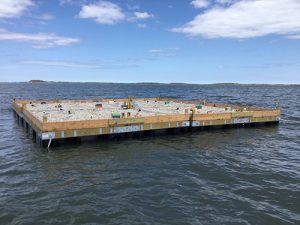
OCEAN CITY — State, local and regional conservation groups announced this week they are partnering to create an artificial island to host certain endangered colonial nesting birds as their natural habitats continue to disappear.
The Maryland Department of Natural Resources (DNR), the Maryland Coastal Bays Program (MCBP) and Audubon Mid-Atlantic are partnering on research and monitoring efforts to preserve three of Maryland’s endangered colonial nesting birds including the common tern, the royal tern and the black skimmer. The species typically nest in small colonies on tiny islands in the coastal bays at certain times of the year, but their natural habitats have come under pressure in recent years from shoreline erosion, sea level rise and even some man-made factors.
The monitored colonial nesting bird populations have declined by as much as 95% since the mid-1980s. To that end, the conservation partnership has undertaken a pilot program to create an artificial island that mimics the ideal bird species’ nesting areas at undisclosed locations around the coastal bays. Local wood artisans John Collins and Todd Peterson designed and constructed the platforms, which are loaded with crushed clam shell and anchored at different locations.
The platforms use a social attraction method that draws the seabirds to the artificial islands with bird decoys and audio recordings of bird calls, a model that has been successful in other parts of the U.S. and Canada, for example. Chick shelters and decoys have been placed on the artificial islands to attract the endangered seabirds to their new ideal nesting grounds.
Audubon Mid-Atlantic Director of Bird Conservation Dr. David Curson explained the importance of maintaining the seabirds natural nesting areas, while creating artificial platforms in the coastal bays to provide alternatives.
“Island-nesting terns and skimmers in the coastal bays are in trouble and are on the cusp of being extirpated, or wiped out, from Maryland as breeding species,” he said. “As suitable habitat for these birds dwindle from the effects of a changing climate like shoreline erosion and sea level rise, it’s more important than ever to do what we can to keep them as part of the coastal ecosystem. We need a two-pronged strategy of ongoing sand management to maintain their natural islands to combat erosion, and provide artificial habitat as an interim measure until the species populations are stable again.”
The nesting platforms will be monitored throughout the season. If the artificial platform program is successful, consideration will be given to launching more of them in the coastal bays around the resort area in the future, according to MCBP’s Roman Jesien.
“We hope that these nesting platforms work in the short-term while we continue our efforts to restore and conserve our natural islands long-term,” he said.
Maryland DNR regional ecologist Dave Brinker outlined just how desperate the situation has become for the threatened and endangered species of nesting birds in the coastal bays.
“In the late 1980s, there were about 3,000 pairs of common terns and 300 pairs of black skimmers nesting in the coastal bays,” he said. “Today, there are fewer than five pairs of black skimmers and only 500 pairs of common terns that nest in Maryland each summer. The nesting platform project is an effort to stop this decline and retain nesting common terns and black skimmers in the Maryland coastal bays.”
The DNR is providing financial and technical support for the artificial island program.
“The steep population declines in these important bird species warrants our immediate attention,” said DNR Secretary Jeannie Haddaway-Riccio. “We are pleased to assist with this interim measure as well as long-term measures to give them the best chance to rebound.”

